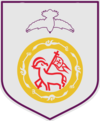Howard West Kilvinton Mowll
Howard Mowll | |
|---|---|
| Archbishop of Sydney | |
 | |
| Church | Church of England |
| Province | New South Wales |
| Diocese | Sydney |
| In office | 1933–1958 |
| Predecessor | John Wright |
| Successor | Hugh Gough |
| Other post(s) |
|
| Previous post(s) | Assistant Bishop and Bishop of Western China |
| Orders | |
| Ordination | 21 September 1913 (as deacon) by Edmund Knox 7 June 1914 (as priest) by Randall Davidson |
| Consecration | 24 June 1922 |
| Personal details | |
| Born | Howard West Kilvinton Mowll 2 February 1890 |
| Died | 24 October 1958 (aged 68) St Luke's Private Hospital, Potts Point, New South Wales |
| Denomination | Anglican |
| Parents |
|
| Spouse |
Dorothy Anne Martin (m. 1924) |
| Education | |
| Alma mater | King's College, Cambridge |
| Coat of arms |  |
Howard West Kilvinton Mowll (2 February 1890 – 24 October 1958) was the Anglican Bishop of Western China from 1925 to 1933, and Archbishop of Sydney from 1933 until his death in 1958.[1][2]
Biography
Mowll was born in Dover and attended Dover College until 1903 and later matriculated at the King's School, Canterbury.[3]
He succeeded William Cassels in 1926 as Bishop of Western China. As a staunch evangelical, upon returning from the mission field of Western China (Sichuan), Mowll experienced early difficulties in a predominantly liberal church before rising to national prominence during the war years. In 1947 he was elected Primate of Australia.
Within a month of World War 2 starting he had formed the Church of England National Emergency Fund, (CENEF), which was supported with volunteers and fundraising by the Sydney Diocesan Churchwomen's Association. CENEF funded huts for recreation and chaplains in military camps around Sydney, as well as at St Andrew's Cathedral, Sydney and other churches around Sydney. To continue to help ex service people after the war and youth work, CENEF raised funds to buy 201 Castlereagh Street, Sydney, and Rathane in the Royal National Park. CENEF leveraged the Castlereagh Street building to buy land at Gilbulla and 117 acres in Castle Hill for a retirement village. This retirement village was one of his great achievements (some say his wife Dorothy was the driving force behind the idea), and became the first retirement village in Australia. Today this site remains the flagship for Anglican Retirement Villages, Diocese of Sydney. In 1947, following the War, he was elected Primate of Australia.
See also
Notes
- ^ Crockford's Clerical Directory 1940-41, Oxford, OUP, 1941.
- ^ "Most Rev. H. W. K. Mowll", The Times, 26 October 1958; p. 10.
- ^ Who was Who 1897–1990, London, A & C Black, 1991, ISBN 0-7136-3457-X.
External links
![]() Media related to Howard Mowll at Wikimedia Commons
Media related to Howard Mowll at Wikimedia Commons
